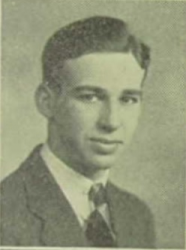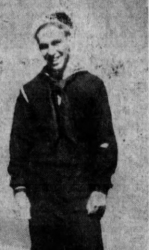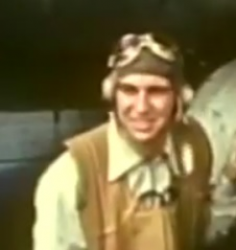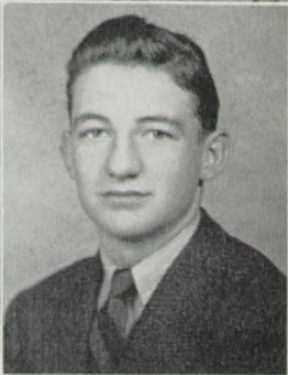
 |
|
|
||
|
WILLIAM FRANKLIN SAWHILL |
||||
|
Engagements: • World War II (1941 - 1945) |
||||
| Biography: | ||||
|
William Franklin Sawhill Aviation Radioman Third Class, United States Naval Reserve Distinguished Flying Cross William was the son of Earl Lockwood Sawhill and Maude Elsie Botdorf who married on New Year’s Day, 1916 in Richland County, OH. William's siblings were Donald Moore, and Mary Margaret Sawhill. William graduated from Mansfield High School in June 1937 where he participated in Cross Country 3, 4; Track 4; Football 2; and Hi-Y 2. His brother, Donald, graduated from Mansfield HS in June 1940 and his sister, Mary Margaret, graduated from Mansfield HS in June 1944. After graduation from high school, William was employed for three years as a salesman in the men’s department at the J.C. Penny store. As the rumbles of war grew louder, William, 21, enlisted in the US Navy (NSN:283 43 86) on 6 Nov 1940 in Cleveland, OH. He was assigned to the Naval Training Station (NTS), Great Lakes, IL for basic training. After graduating from "boot camp," Sawhill was detached from NTS, Great Lakes and transferred to the Naval Air Station (NAS), San Diego on 25 Jan 1941 as an Apprentice Seaman (AS). He attended the radioman school in San Diego, and while there, Sawhill was advanced in rate to Seaman Second Class (S2/c) on 6 Mar 1941. On 27 May 1941, he was detached from NAS San Diego and transferred to the light cruiser, USS Raleigh (CL-7) Aviation Unit. On 01 Aug 1941, Sawhill was advanced in rate to Seaman First Class (S1/c). Several months later, on 01 October 1941, S1/c Sawhill was detached from the Raleigh Aviation Unit and transferred to NAS, Norfolk. Later that year, he was transferred to Torpedo Squadron Eight (VT-8) embarked on board the aircraft carrier USS Hornet (CV-8). He was advanced in rate to Aviation Radioman Third Class (ARM3) in early 1942. For the next four months, VT-8 and Hornet conducted extensive training in the Atlantic and Caribbean areas. In early March 1942 Hornet was steamed to the Pacific via the Panama Canal where she participated in the Doolittle raid on Tokyo in April 1942. Shortly after returning from the Doolittle raid, Hornet, along with the aircraft carrier USS Enterprise (CV-6), was ordered to support the aircraft carriers USS Lexington (CV-2) and USS Yorktown (CV-5) during the battle of the Coral Sea in early May 1942. However, the battle was over before they reached the area. Hornet returned to Pearl Harbor in late May and was ordered to prepare to support impending combat operations near Midway. She was underway on 28 May and in company with the Enterprise steamed toward the Midway Atoll. Yorktown followed soon after. Early on the morning of 4 Jun 1942, Ensign Ulvert M Moore and his radioman/gunner, ARM3 William F. Sawhill, and the rest of the aircraft of VT-8 in company with the Hornet Air Group, launched to engage an enemy Japanese Striking Force approaching the Midway Atoll. After a long flight westward, the Hornet Air Group had not made contact with the enemy force. VT-8’s commanding officer, Lcdr John Waldron, decided he knew where the enemy force was. Against orders, Waldron and VT-8 left the Hornet Air Group and headed southwest. A short while later VT-8 found the enemy ships and courageously attacked without friendly fighter support. Overwhelmed by superior numbers of Japanese fighters, yet undaunted, VT-8 pressed home their attack until all 15 planes were shot down. Only one person survived, Ens. George Gay. According to the Hornet's after action report dated 13 Jun 1942 ARM3 Huntington were listed as "missing in action." His remains were unrecoverable. Huntington were presumed dead on 5 Jun 1943. In that same report Rear Admiral (Select) Marc A. Mitscher, Hornet CO, nominated each member of Torpedo Eight who flew into battle on 4 Jun 1942 for the Congressional Medal of Honor. Petty Officer Sawhill was awarded (posthumously) the Distinguished Flying Cross, the Purple Heart, Presidential Unit Citation ribbon, American Defense Service Medal, American Campaign Medal, Asiatic-Pacific Campaign Medal with one bronze battle star and the World War II Victory Medal.. Note: [None of the flight crews were awarded the Combat Action Ribbon (CR). See Navy and Marine Corps Awards Manual (SECNAVINST 1650.1H of Aug 22, 2006, Chapter 2, Section 3, p2-34). It reads in part, “The CR will not be awarded to personnel for Aerial Combat, . . . “] ---------------------------------------------------------- Distinguished Flying Cross Citation reads: The President of the United States of America takes pride in presenting the Distinguished Flying Cross (Posthumously) to Aviation Radioman Third Class William Franklin Sawhill, United States Navy, for heroism and extraordinary achievement while participating in an aerial flight as radioman and free machine gunner of a carrier-based Navy Torpedo Plane of Torpedo Squadron EIGHT (VT-8), attached to the U.S.S. HORNET (CV-8), during an attack against enemy Japanese forces in the "Air Battle of Midway," on 4 June 1942. Grimly aware of the hazardous consequences of flying without fighter protection, and with insufficient fuel to return to his carrier, Aviation Radioman Third Class Sawhill resolutely, and with no thought of his own life, pressed home his attack with utter disregard for his own personal safety and in the face of tremendous anti-aircraft barrage and overwhelming fighter opposition. His gallant spirit of self-sacrifice and his conscientious devotion to the fulfillment of a vastly important mission contributed materially to the success of our forces and were in keeping with the highest traditions of the United States Naval Service. -------------------------------------------- Presidential Unit Citation presented to Navy Torpedo Squadron Eight (VT-8). The Citation reads: For extremely heroic and courageous performance in combat during the Air Battle of Midway, June 4, 1942. Flying low without fighter support, Torpedo Squadron EIGHT began the perilous mission, Intercept and attack! First to sight the enemy, the squadron attacked with full striking power against crushing enemy opposition, scoring torpedo hits on Japanese forces. Realizing to a man that insufficient fuel would prevent a return to the carrier, the pilots held doggedly to the target, dropping torpedoes at point-blank range in the face of blasting antiaircraft fire that sent the planes one by one, hurtling aflame in the sea. The loss of 29 lives, typifying valor, loyalty, and determination, was the price paid for Torpedo Squadron EIGHTs vital contribution to the eventual success of our forces in this epic battle of the air. ------------------------------------------ His family also received an honor scroll from President Franklin D. Roosevelt in commemoration of William’s sacrifice. The citation reads: In grateful memory of William Franklin Sawhill who died in the service of his country, SEA, Pacific Area, ATTACHED U.S.S. HORNET, 5 JUNE 1943 (Presumed)*. He stands in the unbroken line of patriots who have dared to die that freedom might live and grow and increase its blessings. Freedom lives, and through it, he lives -- in a way that humbles the undertakings of most men. (Signed) Franklin D. Roosevelt, President of the United States (*Presumed dead on 5 Jun 1943. Actual date gone missing was 4 Jun 1942 ------------------------------------------ News –Journal (Mansfield, Ohio) – 19 Jun 1942, Fri – p. 1 William Sawhill Missing, Parents Told In Wire. By Alvin L. Krieg Another Mansfield family received official notification today that their son – William Sawhill, 22, radio man (sic) on a torpedo plane attached to an aircraft carrier in Pacific service – is “missing in action.” The parents, Mr. and Mrs. Earl Sawhill, 409 West Fourth street, were anticipating the telegram to arrive today, because by an unusual circumstance they had received earlier notification from the commanding officer of the carrier. An air mail letter received yesterday informed the family that their son was listed as “missing in action.” This was the first instance in cases of this sort that any Richland county family has received word from the serviceman’s commanding officer before the official notice arrived from either the war or navy departments. Sawhill, a radio man third class is the 10th Mansfielder to be listed as “missing in action” since the start of the war, and two others – both officers in the army air corps, were killed in a plane crash in India. Of the nine others listed as “missing in action,” one other, Wilbur B. Linn, was in the navy. Neither of the communications received by the Sawhill family gave any details. The parents, however, expressed belief that their son had participated in the battle at Midway, and that this was the action which resulted in William being listed as missing. They received a letter on June 1 which their son had written on May 20, more than a week after the Coral sea battle. The letter from the commanding officer of the carrier (the Navy department requests that neither the name of the captain nor the carrier be divulged) read as follows: “The sad news that your son William is missing in action has, I am sure, already been sent to you by the Navy department. We shall all of us continue to hope that he may yet be found. I hope that you will receive some degree of consolation in the knowledge that he has served his country to the fullest measure and has rendered service of inestimable value. All his shipmates join me in expression of deepest sympathy.” The Navy department’s telegram sent by Rear Admiral Randall Jacobs, chief of naval personnel, told the family that further information will be supplied as soon as it is received. Born in Mansfield, William graduated from Senior high school, where he was a member of the track team and was prominent in other extra-curricular activities. After graduation, he worked briefly at Isaly’s and then for three years as a salesman in the men’s department at the J.C. Penney store. He was active at Grace Gospel Tabernacle, of which he was a member. He enlisted in the Navy Nov. 6, 1940, and received his training at the Great Lakes Naval Training station and at the Navy radio school in San Diego. He was stationed for a time on the light cruiser U.S.S. Raleigh, but last October applied for transfer to the carrier when he learned there were vacancies. His mother saw him last at Norfolk, Va., in February. The carrier at that time was stationed in Norfolk, and later was transferred to the Pacific scene. [original article edited for content] ----------------------------------------------------------------------News-Journal (Mansfield, OH) – 26 Jun, Fri – p. 1 Get ‘Last Letters’ Missing Son Wrote On Eve of Battle From their sailor-son now listed as “missing in action,” a Mansfield father and mother today received a packet of letters – including one which he wrote just before the start of a sea battle and gave to his commanding officer to mail in case he failed to return. The sailor is William Sawhill, 22, radio man and gunner on a torpedo plane attached to an aircraft carrier in Pacific service. He is the son of Mr. and Mrs. Earl Sawhill, 409 West Fourth street. Accompanying the three letters from William was a letter written by the commanding officer of the carrier, who said: “I am enclosing letters which your son asked be forwarded in case of his failure to return.” The officer’s letter expressed sympathy and added: “Since all our aircraft carry rubber life rafts there is still a chance that he may still be safe. We shall continue to hope so.” In one of the letters, William urged his parents to remember that “we may go down at sea and turn up weeks or even years later.” He recalled the incident of three sailors being rescued after 45 days on a rubber raft. “So you see there is always a chance,” he wrote. The last letter was written May 31, and addressed to “Dear Mom, Dad, Don and Mary.” Don and Mary are his brother and sister. “This letter,” Mrs. Sawhill said today, “has brought me more comfort than I ever believed I could receive. My hope is that it may be a comfort, too, to other mothers.” This letter contained a number of personal references, and said, in part: “This letter will be mailed only if I do not get through battle, which we expect to come off at almost any hour. I am making a request that this be mailed as soon as possible after I fail to return. “I want you all to know that I am not in the least worried, and Mom, you can be sure I have been praying every day. “The best of luck to all of you and I will be seeing you all when life will be much different ‘up there.’ Be sure and remember I am only one of many, and you also are only one of many. “Love – Bill.” The family received first notification on June 18 that William was “missing in action.” Born in Mansfield, William graduated Senior high school and worked for three years at the J.C. Penney store. He was also an active member of Grace Gospel Tabernacle. --------------------------------- News-Journal (Mansfield, OH) – 15 July 1942, Wed – p. 1 Three Ohioans, One a Mansfielder, Play Vital Roles in U.S. Triumph at Midway Sawhill Was Member of Daring Squadron Japs Wiped Out Three Ohioans, one of them a Mansfield sailor, were listed today by the Navy as among those who played vital roles in the battle of Midway. The Mansfield sailor cited was William F. Sawhill, 22, crew member with the squadron of 15 torpedo planes which failed to return from the sea fight but was credited by officers with making the Midway victory possible. Also honored was Capt. Elliott Buckmaster, 52, of Columbus, who commanded the aircraft carrier Yorktown, whose planes located and participated in the sinking of the Japanese carrier Hiryu. The Yorktown later was put out of action but her planes operated from other carriers. The third Ohioan listed by the Navy was Major Lofton R. Henderson of the U.S. Marine aviation corps, son of Mr. and Mrs. Fred Henderson, Lorain, and a graduate of U.S. Naval Academy at Annapolis. During the marines’ first attack on the Japanese fleet on June 4, Henderson’s scout bomber was hit and set aflame. He was last seen diving his flaming and disabled craft into the smokestack of a Japanese aircraft carrier. Henderson’s brother, Paul, is also a marine corps officer. Although Sawhill was singled out for heroism, his mother, Mrs. Earl Sawhill, 409 West Fourth street, was pleased but not excited by the recognition. “My only hope is that this encourages more mothers to pray for their sons,” she said. “The greatest thing to me is in knowing that he was ready to meet his Lord when he died.” Sawhill wrote a letter to his parents just before taking off on his last flight and asked his commanding officer to mail it if he failed to return. “We may go down at sea and turn up weeks or even years later,” he wrote. He recalled an incident of three sailors being rescued after 45 days on a rubber raft. Sawhill, a radio man (sic) and gunner, was a member of Torpedo Squadron No. 8, “suicide” unit which hunted out the Japanese fleet after the American navy had lost contact with it and paved the way for the victory. Sawhill flew in one of the 15 planes in the squadron. None of the 15 planes came back and only one of the 30 crew members survived the battle. Torpedo Squadron No. 8 was given credit for crippling Jap air power at the start of the battle and for making the victory possible. Sawhill was a member of the squadron whose leader, Lieut. Commander John C. Waldron, volunteered “to share any mission, regardless of the consequence.” The squadron was sent out to find the Japanese force which had been sighted moving toward Midway but which had been lost when it diverted its course. Squadron 8 found the “lost” Japanese force and attacked, although it had no fighter support to divert enemy defensive fire. “The sky swarmed with the Jap Zeros,” said the Navy’s detailed report issued yesterday, “and a seemingly impenetrable screen of cruisers and destroyers protected its carriers. Nevertheless No. 8 deliberately pressed home its attack at short range. Plane after plane of the group was shot down in flames.” Planes left in the sky launched torpedoes at enemy carriers and made certain “that the Jap’s air power was crippled at the start,” the navy reported. Forty minutes later, a second American squadron arrived at the scene but only one man of No. 8 survived. He was Ensign C.H. (sic) Gay, Houston, Tex., whose plane was shot down but who managed to inflate his rubber boat when his plane struck the water. He remained in the vicinity of the battle un-noticed by the enemy and had a sort of water level view of the battle as it raged. When enemy planes flew over, he covered his head to avoid detection. He was picked up later by American vessels. “My boy is just one among millions,” said Mrs. Henderson, of Lorain, when she learned that her aviator son had crashed his burning plane into a Jap carrier. “I’m deeply proud of him but countless other sons and mothers are going through the same things,” she said. Major Henderson had been notified that he had been recommended for promotion to the rank of Lieutenant-colonel just before his departure for the war zone in April. However, since navy communiques referred to him as major, it was believed that formal action on his promotion had not yet been completed at the time of his death. A fellow marine told his superiors he was convinced Henderson’s diving into the smokestack of a Jap carrier was deliberate. Henderson’s parents have another son in the marine corps (sic), Capt. Paul Henderson, stationed in the field artillery on the west coast. [Bio compiled by GML470] |
||||
| Honoree ID: 101312 | Created by: MHOH | |||
Ribbons
Medals
Badges
Honoree Photos
 |  |  |
 |  |
 |


